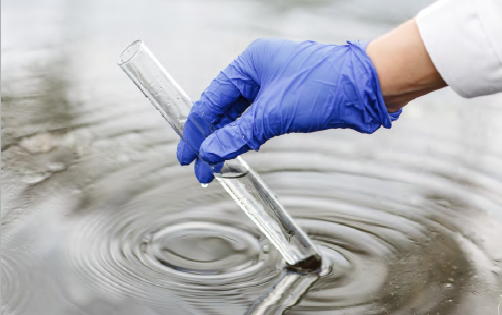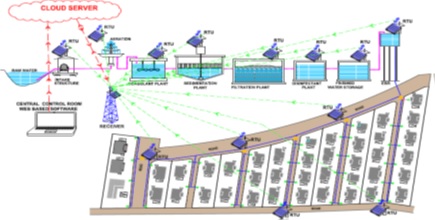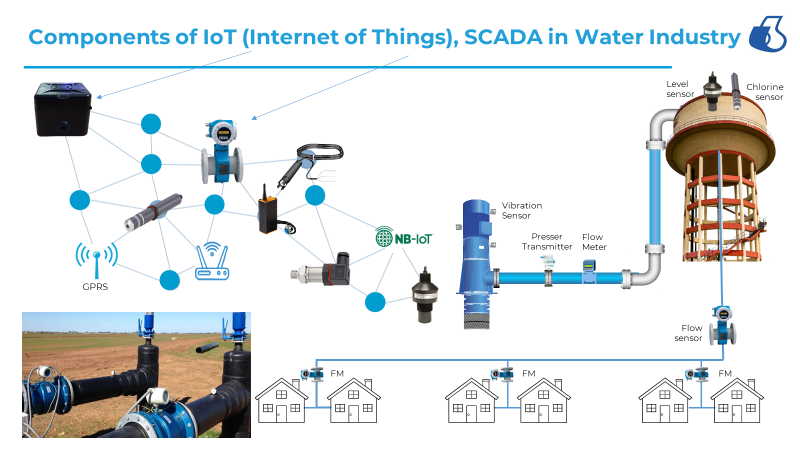By Praveen Kumar S
All about the extremely powerful silica sand based catalytic water filtration media that is designed for removal of Iron and Manganese without the use of potassium permanganate.
The character of water is changing across India and hence adopting new measures of quality is highly
Important. Ground water in India is now getting affected by heavy metals which are beyond the permissible limit. Presence of Fe (Iron), Arsenic, Manganese, in water, to name a few are
Quite detrimental for human consumption. We have plenty of water resources, but in a polluted form thereby making them usable with less financial input is a question that is in the air already. DMI65, a revolutionary iron removal medium produced by Quantum Filtration Pte Ltd, Australia is the new solution for this problem.
Conventional mediums.
There are conventional mediums like sand, anthracite, green sand and so on which could be used when the resultant water quality is not critical and when the feed water is not complex. These
Mediums were originally used and still hold a good market share in cleaning ground water. This was followed by treated sands mainly with manganese oxide (MnO2) as a medium applied to a basic natural mineral to form a filtration medium. This works with the principle of oxidation. The technology behind those mediums date to at least 40 years before. The operating conditions of
Those medium were too complex in some cases, whereas some mediums did not render constant results in water chemistry. There are few mediums that work technically outstanding but their pricing methodology makes them somewhat an expensive affair to deal with.
The technology on offer.
DMI65 on other hand is a technology developed about 20 years ago in R&D level and got into commercial production in the last 10 years. The technology behind is infusion of MnO2
Onto the microporous structure of Silicon Dioxide. DMI-65 is an extremely powerful silica sand based catalytic water filtration media that is designed for removal of Iron and Manganese without
The use of potassium permanganate. The unique microporous structure of DMI-65 efficiently removes dissolved iron to almost undetectable levels as low as 0.001 PPM and manganese to 0.001
PPM. DMI-65 acts as an oxidation catalyst with immediate oxidation and filtration of the insoluble precipitates derived from this oxidation reaction. DMI-65 can also remove Arsenic, Aluminium and other heavy metals and Hydrogen Sulphide under certain conditions. DMI-65 is infused technology and not just a surface coating technology unlike other catalytic water filtration media, giving DMI-65 the advantage of a long life span between 5 to 10 years and powerful performance. It also removes the chance of any chemical leaching into the water stream. It is a media that utilises an oxidation,
Adsorption and filtration process similar to Greensand and Brim, but at a much higher level of performance and capacity and significantly lower whole of life cost. The media has been used extensively in many countries for drinking water applications and in a wide variety of other applications to prevent nuisance iron and manganese bio fouling in water treatment systems. DMI-65 has been certified to the US Standard of NSF/ANSI 61 for Drinking Water System Components and for use in England and Wales under Regulation 31(4) (a) of the water supply (Water Quality) regulations 2010 and has also been tested by many other water treatment authorities and laboratories.
WHAT ARE THE ADANTAGES OF DMI65 REGENERATION NOT REQUIRED
The media operates with a continuous injection of sodium hypochlorite at low residual levels (0.1 to 0.3 ppm) which eliminates the need for regeneration with Potassium Permanganate which are
Both cost and time expensive. LONG LIFE DMI-65 is not consumed in the process giving it an expected operational life of up to 10 years, providing considerable advantages over other processes or media. The media does not display a decaying capacity to do its catalytic work. Over the 5 to 10 year period, through many backwashing operations of the bed to remove retained solids, an attrition loss of the media occurs by contact between particles and mechanical abrasion.
HIGH LOAD CAPACITY
Because of the increased surface area owing to the micro-porous structure of the matrix material, DMI-65 has higher iron and manganese load capacity which can extend the duration of filter runs and the time between backwashing, thereby reducing downtime, operating expense and wastage. Reduced Total Water Treatment Solution costs the use of DMI-65 in a water treatment solution for
The removal or iron and manganese contributes to a reduction in the capital investment cost of the water filtration solution:
HIGH FLOW RATES
The infused technology of DMI-65 promotes the highest oxidation rate of any catalytic filtration media. This permits a significantly higher water flow rate to achieve the same level of iron and
Manganese removal. DMI-65 can operate at linear filtration velocities up to twice that of conventional media with a corresponding reduction in capital equipment costs.
REDUCE REDUNDANCY
Iron and Manganese contamination can materially reduce the performance of water treatment systems. The effectiveness of DMI-65 in removing iron and manganese contamination levels
Allows the water filtration system to function closer to rated levels thereby reducing the amount of costly overcapacity that would be acquired to achieve required output levels.
WIDEOPERATING ENVIRONMENT
Stable and satisfactory performance at pH 5.8 to 8.6. And a maximum operating temperature of 113° F (45°C) reduces the need for investment to alter the operating environment
HOW THIS WORK? DMI-65 Advanced Oxidation Process
Our Advanced Oxidation Process (“AOP”) uses the highly reactive catalytic material DMI-65 to boost the reduction/oxidation (redox) processes in water. This material promotes stronger Oxidation than molecular oxygen and ordinary oxidants. Under certain conditions heavy metals may be difficult to oxidise to insoluble hydroxides, however our DMI-65 based AOP increases the rate of reaction and achieves a higher degree of purification. In essence, the oxidants and the media Work together to oxidize a dissolved solid into a suspended solid that is then filtered out in the depth of the media bed. If an element can’t be oxidized and precipitated the media can’t remove it. The media helps chemical reactions to occur by interacting with the oxidation reaction without being permanently altered. Iron and manganese exist in bore water as bicarbonate. DMI-65 acts as an oxidation catalyst in the true meaning of the word and facilitates oxidation precipitation filtration. Strictly speaking, the media facilitates chemical reactions and does not explicitly remove anything, though once oxidised, the depth filtration aspect of the media removes the solids created by the oxidation that are then periodically backwashed out of the filter vessels. Chlorine, fed as sodium hypochlorite or
Bleach (12.5% Nicoll), is the preferred oxidant since it is relatively inexpensive, readily available around the world and it is effective. Other oxidants such as hydrogen peroxide (H2O2), chlorine dioxide (ClO2) or ozone can also be used so long as a residual can be measured and maintained. Choice of oxidants needs to be subject to detailed analysis as performance varies according to the
Operating environment. Another function of the chlorine is that it keeps the media free from bacterial bio-fouling or slime growth which reduces its performance. The need to add an oxidizer as part of the DMI-65 process also means that the final stage of the disinfection process of water treatment is also addressed.
Key DMI-65 operating conditions
Treatment processes have to be conducted in such manner so that the catalytic surface of the material is kept clean and available to ion from water to contact. Water with a large amount of
Suspended solids has to be clarified before passing it through the catalytic filter with DMI-65. Acceptable levels of suspended solids depends on their nature. A larger amount of mineral suspended solids than organic suspended solids could be handled. Bacteria could grow and deposit slime on DMI-65. Thus disinfectant and oxidation conditions have to be maintained. Water containing clays and large organic molecules may result in deposition of such material on the
Surface of DMI 65 and blinding of the catalytic surface. Treatment for removal of such contaminant before the catalytic filter is needed. Polymer flocculent could also stick to the DMI-65 and blind catalytic surface. Hard, unstable groundwater could cause scale deposition in the catalytic
Filter and blind the material in a solid mono bloc. In such case the DMI-65 material in the bed is lost and would have to be replaced. Treatment for stabilizing the water to prevent scale formation in
The catalytic filter has to be carried out. Both low acidic pH and anoxic conditions could cause dissolution of manganese from catalytic layer of DMI- 65 and loss of its capacity. Excessively
High pH means excessive concentration of hydroxyl ions (corrosive to metals) and could also cause dissolution of manganese from the catalytic layer. Do not use demineralized water, distilled
Water or water known to be strongly corrosive to metals for activation of DMI- 65. DMI65 is now actively sold in Indian sub-continent and MEDIO based out of Kerala, is its exclusive dealer in India





